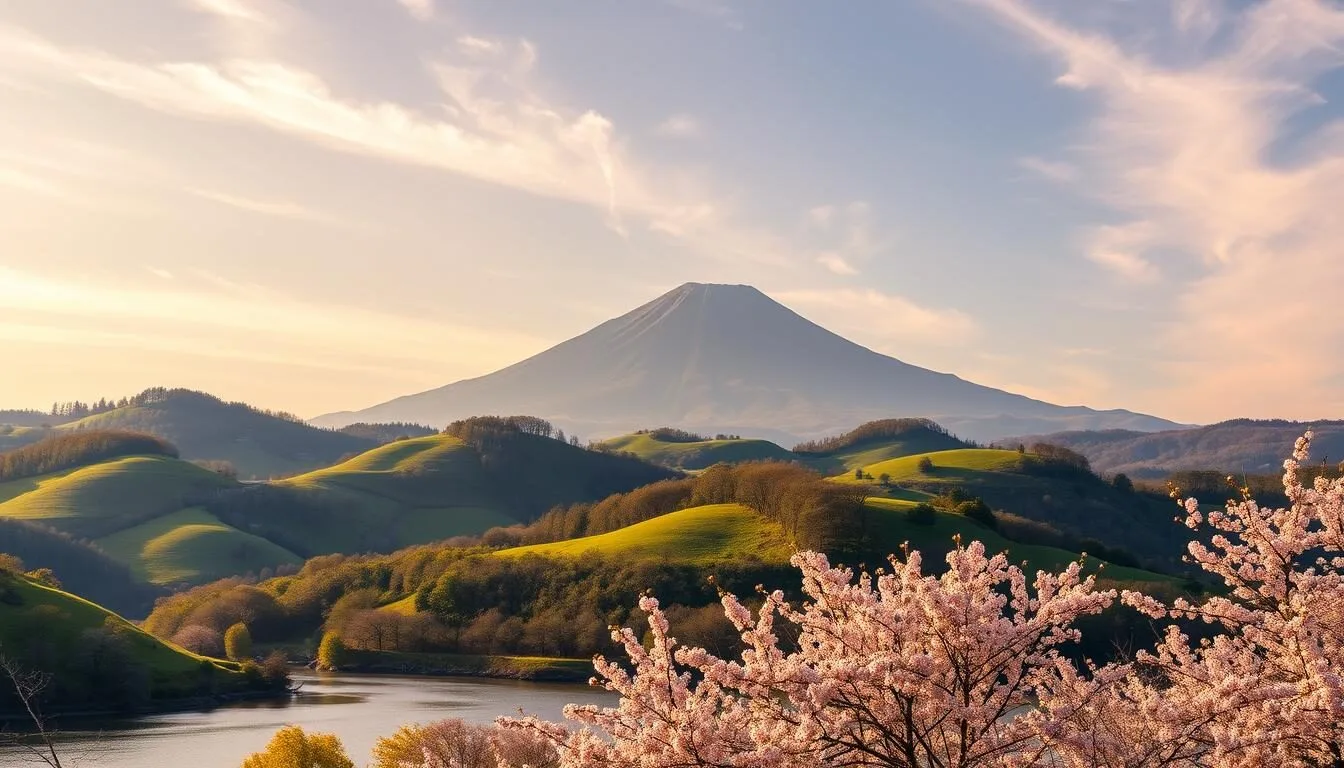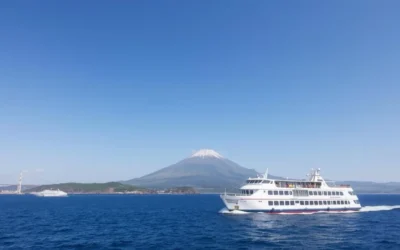✓ Accommodations✓ Flights✓ Rental Cars
Planning a trip to Yamaguchi Prefecture can be a delightful experience, with its rich history, stunning natural beauty, and vibrant culture. However, the prefecture’s weather patterns play a significant role in shaping the travel experience.
Understanding the seasonal variations is crucial to making the most of your visit. The temperature in Yamaguchi varies significantly throughout the year, ranging from 34°F to 86°F, with distinct seasonal characteristics.
The ideal time to visit depends on your preferences and the activities you have planned. Whether you’re interested in cherry blossom viewing, fall foliage, or winter festivities, this guide will help you navigate Yamaguchi’s climate to determine the best time for your trip.
Discovering Yamaguchi Prefecture: Japan’s Hidden Gem
Discover the charm of Yamaguchi Prefecture, a lesser-known Japanese destination that offers a unique blend of traditional culture, historical landmarks, and natural beauty. As you plan your trip, understanding the prefecture’s characteristics will enhance your travel experience.
Geographic Location and Significance
Yamaguchi Prefecture is located at the western tip of Honshu, Japan’s main island. Its strategic position has made it an important hub for trade and cultural exchange throughout history. The prefecture’s diverse geography, ranging from coastal areas to mountains, contributes to its rich biodiversity and scenic landscapes.
Cultural and Historical Importance
Yamaguchi has played a significant role in Japan’s history, particularly during the Sengoku period. The prefecture is home to numerous historical sites, including the famous Kiyomizu-dera Temple and the Yamaguchi Prefectural Museum. These cultural treasures offer insights into the region’s past and its influence on Japanese heritage.
Why Weather Matters When Visiting Yamaguchi
The weather in Yamaguchi significantly impacts the visitor experience, with distinct seasons offering various advantages and challenges. Understanding the local climate helps you pack appropriately, plan suitable activities, and make the most of your time in this beautiful prefecture. For instance, the best time to visit for pleasant weather is from late August to mid-October, making it an ideal season for outdoor activities and travel.
By considering these factors, you can optimize your travel plans to Yamaguchi Prefecture, ensuring a memorable and enjoyable experience.
Yamaguchi’s Climate Overview: What to Expect Year-Round
Located on the western tip of Honshu, Yamaguchi Prefecture boasts a distinct climate that sets it apart from other regions in Japan. This uniqueness is largely due to its geographic position, nestled between the Sea of Japan and the Seto Inland Sea.
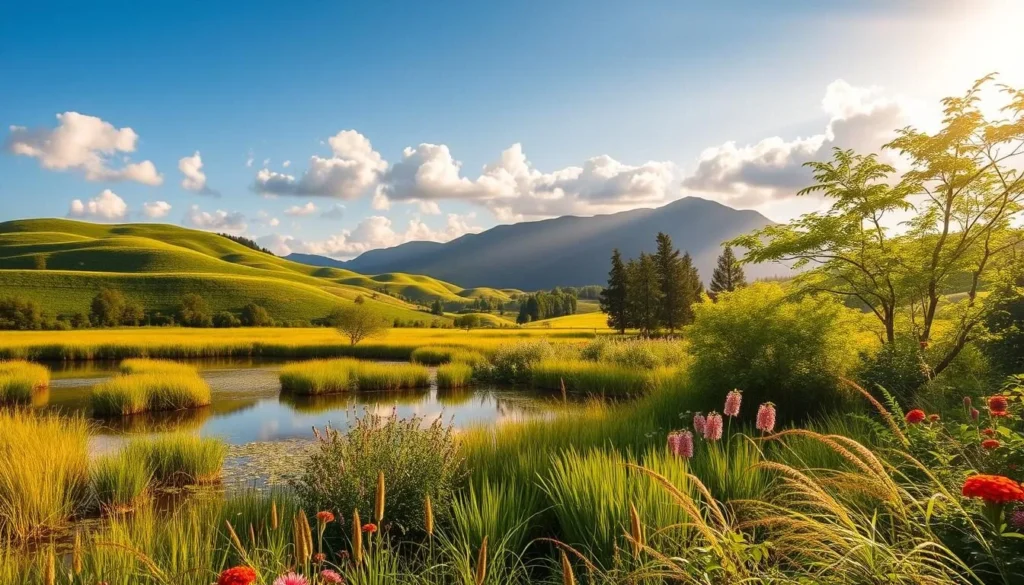
Temperature Patterns Throughout the Year
Yamaguchi experiences a temperate climate with four distinct seasons. Spring (March to May) brings mild temperatures, ranging from 10°C to 20°C (50°F to 68°F), making it an ideal time to visit. Summer temperatures can soar, but are generally more moderate than in inland areas. Autumn (September to November) is characterized by comfortable temperatures, while winters are relatively mild, especially compared to northern Japan.
Precipitation and Humidity Levels
The prefecture experiences a rainy season in early summer, with June being the wettest month. Humidity levels are relatively high during the summer months. However, the region’s precipitation patterns vary, with some areas receiving more rainfall than others due to its microclimates.
How Yamaguchi’s Weather Differs from Other Japanese Regions
Yamaguchi’s climate differs significantly from other parts of Japan. Compared to Hokkaido in the north, Yamaguchi has milder winters and warmer summers. Unlike Tokyo and other eastern regions, Yamaguchi experiences slightly milder winter temperatures but can have more rainfall during certain seasons. The prefecture’s unique position creates microclimates, with coastal areas experiencing different conditions than inland regions.
Understanding these regional differences helps you decide the best time to visit Yamaguchi as part of a larger Japanese itinerary. Whether you’re looking to enjoy the cherry blossoms in spring or the autumn foliage, Yamaguchi offers a unique experience throughout the year.
Spring in Yamaguchi Prefecture (March-May)
As spring unfolds, Yamaguchi Prefecture transforms into a vibrant landscape, making it an ideal time to visit. The season brings a kaleidoscope of colors and a gentle warmth that is perfect for exploring the region’s diverse attractions.
March: Early Spring Transitions
In March, Yamaguchi Prefecture experiences the transition from winter to spring, with temperatures gradually warming up. The weather is generally mild, making it a good time for outdoor activities. Average temperatures range from 45°F to 60°F (7°C to 15°C), providing a comfortable climate for sightseeing.
April: Cherry Blossom Season and Festivities
April is a highlight of the spring season in Yamaguchi, with the famous cherry blossom season in full bloom. The prefecture’s parks and gardens are filled with beautiful sakura, attracting visitors from all over. The weather is usually pleasant, with average highs around 70°F (21°C), making it perfect for outdoor festivities and cherry blossom viewing. As the weather warms up, the prefecture comes alive with various festivals and events celebrating the arrival of spring.
May: Pleasant Temperatures and Outdoor Activities
May brings some of the most pleasant temperatures in Yamaguchi, ranging from 57°F to 71°F (14°C to 22°C). The landscape is lush and green following the spring rains, making it an excellent time for nature photography and outdoor activities. While early May coincides with Golden Week, a period of national holidays that attracts domestic tourists, visiting in mid to late May allows you to enjoy the pleasant weather without the crowds. It’s an ideal period for hiking, exploring coastal areas, and visiting historical sites before the summer humidity sets in.
Some of the key benefits of visiting Yamaguchi in the spring include:
- Pleasant weather conditions ideal for outdoor activities
- Lush and green landscapes following spring rains
- Colorful displays of spring flowers beyond cherry blossoms
- Comfortable temperatures and extended daylight hours
Overall, spring is a best time to experience Yamaguchi Prefecture’s natural beauty and cultural heritage. Whether you’re interested in nature, history, or simply enjoying the local cuisine, spring offers a wonderful opportunity to explore this hidden gem of Japan.
Summer Months in Yamaguchi (June-August)
The summer season in Yamaguchi is characterized by hot temperatures and high humidity, but it’s also a great time to enjoy the prefecture’s coastal escapes and festivals. As you plan your visit, it’s essential to be aware of the weather conditions and how they impact the activities and experiences available.
June: Early Summer and the Beginning of Rainy Season
In June, Yamaguchi welcomes early summer with warm temperatures and increased humidity. This period also marks the beginning of the rainy season, known as “Tsuyu” or “Baiyu,” which brings significant rainfall to the region. While the rain can make some outdoor activities challenging, it’s a great time to enjoy the prefecture’s lush greenery and fewer crowds.
July: Peak Heat and Humidity Considerations
July is one of the hottest months in Yamaguchi, with temperatures often reaching their peak. The high heat and humidity can be challenging for sightseeing, but early mornings and evenings offer more comfortable conditions for exploration. You can make the most of your visit by focusing on water activities, visiting air-conditioned attractions, and enjoying the prefecture’s summer festivals.
August: Summer Festivals and Coastal Escapes
August is Yamaguchi’s hottest month, with average highs of 85°F (29°C) and lows of 74°F (23°C). Despite the heat, this month is ideal for experiencing the prefecture’s vibrant culture through its numerous summer festivals, or “matsuri.” Mid-August brings Obon, an important cultural festival that honors the spirits of one’s ancestors. Coastal areas become popular escapes, offering relief from the heat with their beautiful beaches along the Sea of Japan and Seto Inland Sea.
- Enjoy water activities and visit coastal areas to escape the heat.
- Experience the prefecture’s rich cultural heritage through its summer festivals.
- Plan your sightseeing during early mornings and evenings for more comfortable conditions.
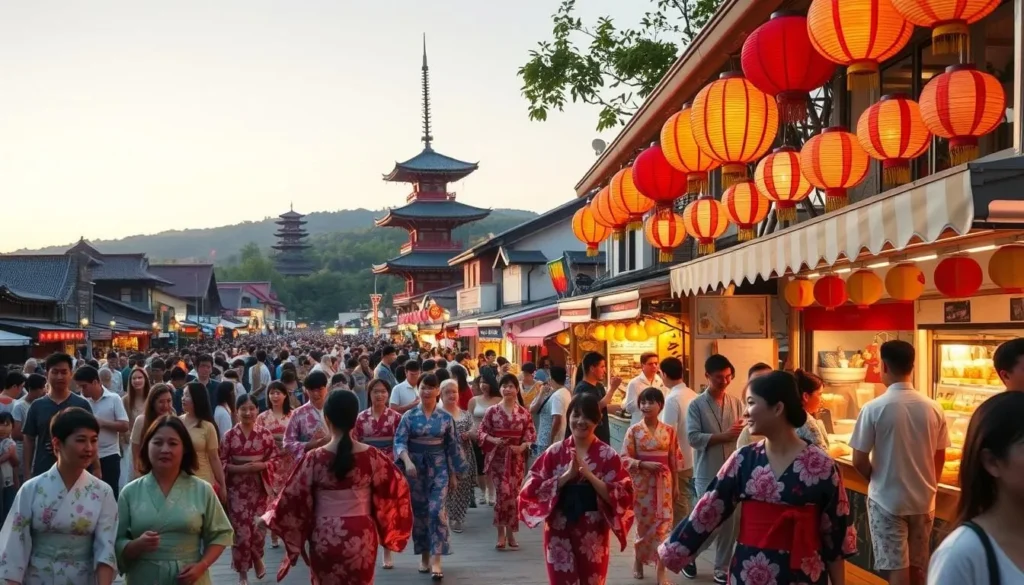
By understanding the weather conditions and planning accordingly, you can have a memorable and enjoyable trip to Yamaguchi during the summer months.
Yamaguchi Prefecture, Japan: Best Months for a Weather-Savvy Trip
For travelers seeking optimal weather conditions, Yamaguchi Prefecture has a sweet spot. The prefecture’s climate makes it an attractive destination during certain periods of the year. When planning your trip, it’s essential to consider the best time to visit for an unforgettable experience.
Late August to Mid-October: The Prime Window
The period from late August to mid-October is considered the prime window for visiting Yamaguchi. This period offers a combination of optimal weather conditions and practical travel advantages. You can enjoy the prefecture’s diverse landscapes without the crowds that are typically present during Japan’s major domestic holiday seasons.
- Comfortable temperatures and low humidity create ideal conditions for outdoor activities.
- Clear skies and excellent visibility enhance views from scenic overlooks and improve photography opportunities.
- Stable weather patterns make it easier to plan your time in Yamaguchi with confidence.
- The transition from summer to fall allows you to potentially capture two seasons in one trip.
Weather Conditions During the Optimal Period
During this time, Yamaguchi experiences pleasant weather with perceived temperatures between 65°F and 80°F. The tourism score favors clear, rainless days, making it the best time for general outdoor tourist activities. You can expect a comfortable climate that is ideal for exploring the prefecture.
Why This Period Offers the Best Travel Experience
This optimal window allows you to experience Yamaguchi at its best. With fewer crowds and more available accommodations, you can enjoy a more relaxed visit Japan experience. The comfortable weather and stable conditions make it an ideal time to explore the prefecture’s diverse landscapes and participate in outdoor activities throughout the year.
By planning your trip during this period, you can make the most of your time in Yamaguchi and enjoy a memorable journey.
Fall in Yamaguchi (September-November)
Fall in Yamaguchi is a season of transition, marked by mild temperatures and stunning foliage, making it an ideal time to visit this hidden gem of Japan. As the summer heat dissipates, the prefecture transforms into a vibrant autumn paradise, inviting travelers to explore its rich cultural heritage and breathtaking landscapes.
September: Transitional Weather and Fewer Crowds
In September, Yamaguchi experiences transitional weather, with temperatures gradually cooling down after the summer peak. This period is characterized by fewer crowds compared to the summer months, making it an excellent time to visit popular sites without the peak season rush. You can enjoy the serene landscapes and begin to witness the early signs of autumn foliage.
October: Fall Foliage and Comfortable Temperatures
October is a highlight of the fall season in Yamaguchi, with the foliage reaching its peak. The comfortable temperatures, ranging from 50°F to 70°F (10°C to 21°C), make it ideal for outdoor activities such as hiking and exploring the prefecture’s natural beauty. The vibrant colors of the changing leaves create a picturesque backdrop for your journey, making it a photographer’s paradise.
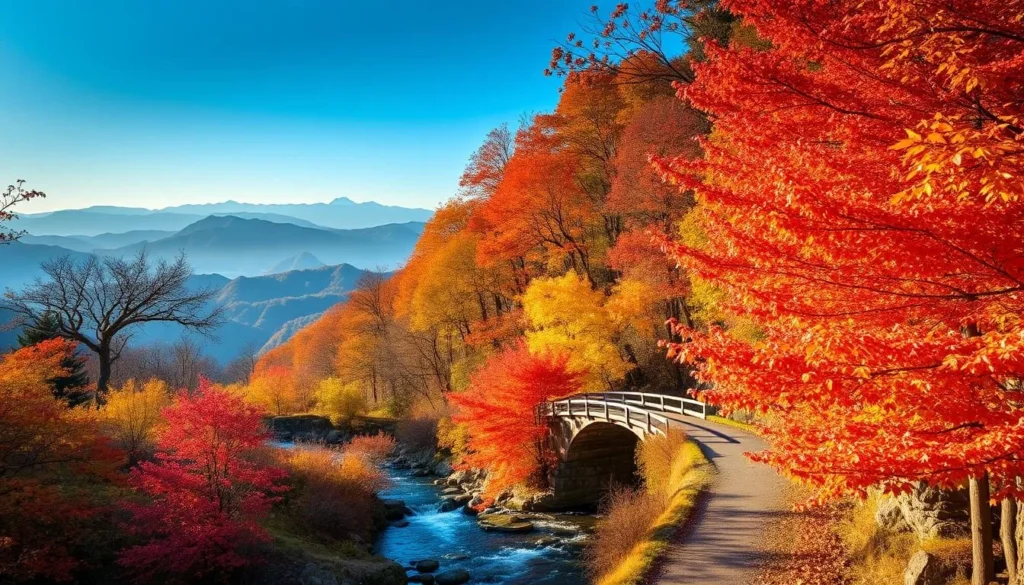
November: Early Winter Preparations
By November, Yamaguchi transitions from fall to early winter, with temperatures cooling further to ranges between 46°F and 60°F (8°C to 16°C). This month offers the last opportunity to enjoy the fall foliage in lower elevation areas, with colors often at their peak in coastal regions. The cooler temperatures make it ideal for enjoying Yamaguchi’s famous hot springs (onsen) and sampling seasonal foods like hot pot dishes and fresh seafood.
| Month | Temperature Range (°F) | Highlights |
|---|---|---|
| September | 60-75 | Transitional weather, fewer crowds |
| October | 50-70 | Peak fall foliage, comfortable temperatures |
| November | 46-60 | Early winter preparations, hot springs, seasonal foods |
As you plan your visit to Yamaguchi, consider the unique charms of each fall month. Whether you’re drawn to the serene landscapes of September, the vibrant foliage of October, or the cozy warmth of November, Yamaguchi has something to offer every traveler.
Winter Experience in Yamaguchi (December-February)
Winter in Yamaguchi, spanning from December to February, brings a serene beauty and a range of activities to enjoy. As you plan your trip, it’s essential to understand the characteristics of each month to make the most of your time visit.
December: Holiday Season and Early Winter
December marks the beginning of winter in Yamaguchi, with the holiday season bringing a festive atmosphere to the region. You can enjoy early winter festivities, and the temperatures start to drop, signaling the onset of colder weather. It’s a great time to experience the local culture and traditions.
January: The Coldest Month and Winter Activities
January is the coldest month of the year, with temperatures ranging from chilly to very cold. Despite the cold, it’s an excellent season for enjoying winter sports and activities, such as skiing and hot spring visits. You can warm up with local specialties like hot sake and steaming bowls of ramen noodles.
February: Winter Festivals and Ume Blossoms
February continues the winter season with temperatures similar to January. However, it’s also a time when the first signs of spring begin to appear with cherry blossom precursors, the ume (plum) blossoms. You can enjoy winter festivals, culinary exploration, and the serene landscapes. It’s a good time visit Japan for those who prefer fewer crowds and lower accommodation prices.
- Experience the unique winter festivals celebrating local traditions.
- Enjoy the early signs of spring with ume blossoms.
- Take advantage of lower accommodation prices and fewer crowds.
- Savor seasonal specialties like fugu (pufferfish) at their peak quality.
- Relax in Yamaguchi’s hot springs, a highlight during the winter chill.
Must-Visit Destinations in Yamaguchi Based on Season
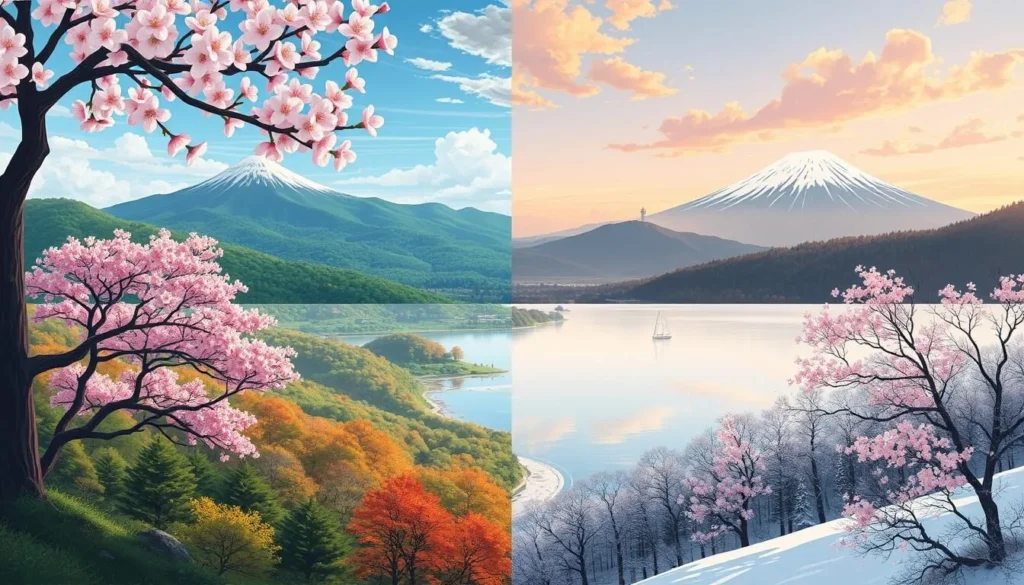
As you plan your trip to Yamaguchi, understanding the best times to visit its various attractions can greatly enhance your travel experience. Yamaguchi Prefecture’s rich historical heritage and diverse landscapes offer numerous sites that are particularly enjoyable during specific seasons.
Coastal Attractions: Best Weather Windows
Yamaguchi’s coastal attractions are best visited during certain times of the year. For instance, Kintaikyo Bridge in Iwakuni is iconic with cherry blossoms in April and lush greenery in summer. The bridge’s changing surroundings make it a must-visit during these seasons.
Mountain and Inland Sites: Optimal Visiting Times
The mountainous regions, such as Chomonkyo Gorge near Yamaguchi City, showcase vibrant greenery in summer and spectacular fall colors in late October to early November. Visiting these areas during these times allows you to fully appreciate their natural beauty.
Historical Sites and Their Ideal Seasons
Image of Rurikoji Temple during cherry blossom season
Historical sites like Rurikoji Temple in Yamaguchi City are enchanting during cherry blossom season (early April) and fall foliage (early November). The historic castle town of Hagi is also most comfortable to explore during spring and fall, when temperatures are ideal for walking tours.
Seasonal Activities and Festivals in Yamaguchi
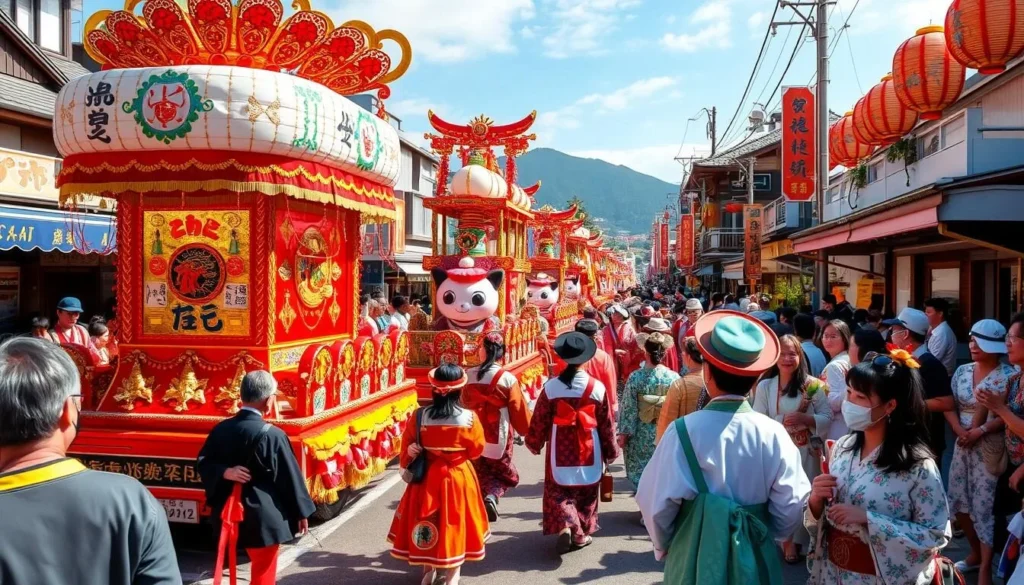
As you plan your trip to Yamaguchi, you’ll discover a diverse array of seasonal events and cultural experiences. Yamaguchi Prefecture is known for its rich history, cultural heritage, and natural beauty, making it an ideal destination for tourists.
Spring and Summer Events
During the spring and summer months, Yamaguchi comes alive with festivals and events. The cherry blossom season in April is a highlight, with many parks and gardens hosting viewing parties. Summer brings obon festivals, where locals honor their ancestors with traditional dances and performances.
Fall and Winter Celebrations
As the seasons change, Yamaguchi’s fall foliage is a major attraction, with maple trees turning brilliant shades of orange and red. Winter brings its own charm, with illuminations and hot spring resorts offering a cozy retreat from the cold.
Year-Round Cultural Experiences
Beyond seasonal events, Yamaguchi offers numerous cultural experiences that can be enjoyed throughout the year. You can participate in traditional craft workshops, savor local culinary delights, or relax at historic hot spring resorts. Whether you’re visiting in the spring, summer, fall, or winter, there’s always something new to discover in Yamaguchi.
Packing Guide for Yamaguchi’s Variable Weather
The key to a comfortable trip to Yamaguchi lies in understanding its weather patterns and packing accordingly. Yamaguchi experiences significant seasonal variations in temperature, precipitation, and humidity throughout the year.
Spring and Summer Essentials
For spring and summer visits, pack lightweight and breathable clothing to stay cool during the warmer months. Don’t forget to include a rain jacket or umbrella for unexpected showers. Comfortable walking shoes are a must for exploring Yamaguchi’s historical sites and natural landscapes.
Fall and Winter Necessities
When visiting in fall or winter, layered clothing is essential to adjust to the changing temperatures. Include warm clothing for the colder months, and consider packing waterproof gear for potential rain.
Year-Round Must-Haves
Regardless of when you visit, certain items will enhance your experience. These include comfortable walking shoes, a day backpack or secure cross-body bag, portable battery chargers, and a reusable water bottle. Additionally, packing basic medications and first-aid supplies, as well as a translation app or pocket dictionary, will prove useful.
| Item | Season | Use |
|---|---|---|
| Lightweight clothing | Spring/Summer | Stay cool |
| Layered clothing | Fall/Winter | Adjust to temperature changes |
| Comfortable shoes | Year-round | Explore historical sites and landscapes |

Comparing Yamaguchi’s Weather with Other Japanese Destinations
Yamaguchi Prefecture’s climate is distinct from other popular Japanese destinations, offering unique travel experiences. Understanding these differences can help you plan your trip more effectively.
Yamaguchi vs. Tokyo and Kyoto
Compared to Tokyo and Kyoto, Yamaguchi has a more moderate climate, with less extreme temperature fluctuations. While Tokyo and Kyoto are known for their crowded cherry blossom seasons, Yamaguchi offers a more relaxed experience during spring. Summer temperatures are similar across the three locations, but Yamaguchi’s coastal areas provide a cooler respite.
| Location | Spring Temp | Summer Temp |
|---|---|---|
| Yamaguchi | 15-20°C | 28-30°C |
| Tokyo | 10-18°C | 25-32°C |
| Kyoto | 10-20°C | 25-33°C |
Yamaguchi vs. Northern Japan (Hokkaido)
Yamaguchi’s climate is significantly warmer than Hokkaido’s, especially during winter. While Hokkaido is known for its heavy snowfall and cold temperatures, Yamaguchi experiences mild winters, making it an attractive destination for those seeking a warmer winter getaway.
Yamaguchi vs. Southern Islands (Okinawa)
Okinawa’s subtropical climate means it remains warm year-round, rarely dropping below 16°C even in winter. In contrast, Yamaguchi experiences four distinct seasons, with cooler winters. Summer temperatures are comparable, but Okinawa benefits from consistent ocean breezes. Yamaguchi’s spring and autumn seasons offer unique attractions like cherry blossoms and autumn foliage, which are not found in Okinawa’s consistent tropical climate.
Planning Your Weather-Perfect Trip to Yamaguchi Prefecture
The key to a memorable trip to Yamaguchi lies in understanding its seasonal patterns and planning accordingly. Yamaguchi Prefecture offers a unique experience throughout the year, with each season bringing its own charm.
For most travelers, the best time to visit Yamaguchi is from late August to mid-October, when comfortable temperatures and clear skies create ideal conditions for exploring. This period is perfect for enjoying the outdoors, whether it’s visiting historical sites or enjoying the natural beauty of the region.
If you’re looking for alternative times to visit, spring (April-May) is ideal for cherry blossom enthusiasts, while fall (October-November) offers spectacular autumn colors. For those sensitive to heat and humidity, avoiding the summer months is advisable.
When planning your trip, consider a two-week itinerary that spans a seasonal transition to experience the best of two seasons. Major cities like Yamaguchi City and Shimonoseki offer indoor activities for less ideal weather, while rural areas are best enjoyed during prime weather windows.
Ultimately, the perfect time to visit Yamaguchi is personal and depends on your preferences and the activities you have planned. By matching your travel preferences with Yamaguchi’s seasonal offerings, you can create your ideal experience in this fascinating part of Japan.
The above is subject to change.
Check back often to TRAVEL.COM for the latest travel tips and deals.
